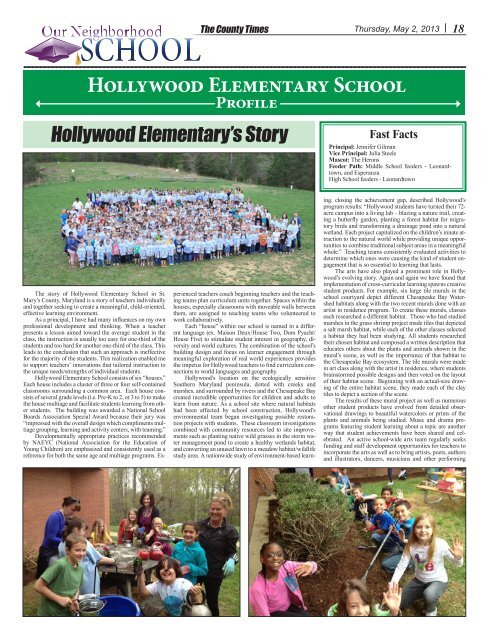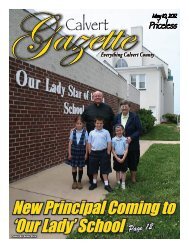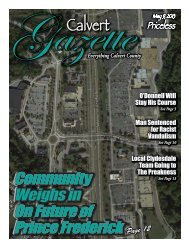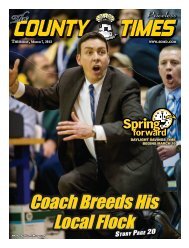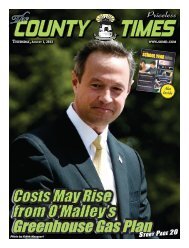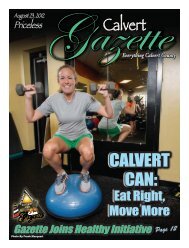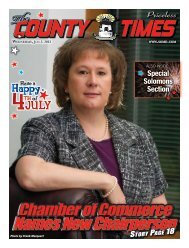thursday,may 2, 2013 - County Times - Southern Maryland Online
thursday,may 2, 2013 - County Times - Southern Maryland Online
thursday,may 2, 2013 - County Times - Southern Maryland Online
- No tags were found...
You also want an ePaper? Increase the reach of your titles
YUMPU automatically turns print PDFs into web optimized ePapers that Google loves.
The <strong>County</strong> <strong>Times</strong>Thursday, May 2, <strong>2013</strong> 18Hollywood Elementary SchoolProfileHollywood Elementary’s StoryFast FactsPrincipal: Jennifer GilmanVice Principal: Julia SteeleMascot: The HeronsFeeder Path: Middle School feeders - Leonardtown,and EsperanzaHigh School feeders - LeonardtownThe story of Hollywood Elementary School in St.Mary’s <strong>County</strong>, <strong>Maryland</strong> is a story of teachers individuallyand together seeking to create a meaningful, child-oriented,effective learning environment.As a principal, I have had many influences on my ownprofessional development and thinking. When a teacherpresents a lesson aimed toward the average student in theclass, the instruction is usually too easy for one-third of thestudents and too hard for another one-third of the class. Thisleads to the conclusion that such an approach is ineffectivefor the majority of the students. This realization enabled meto support teachers’ innovations that tailored instruction tothe unique needs/strengths of individual students.Hollywood Elementary School consists of six “houses.”Each house includes a cluster of three or four self-containedclassrooms surrounding a common area. Each house consistsof several grade levels (i.e. Pre-K to 2, or 3 to 5) to makethe house multiage and facilitate students learning from otherstudents. The building was awarded a National SchoolBoards Association Special Award because their jury was“impressed with the overall design which compliments multiagegrouping, learning and activity centers, with teaming.”Developmentally appropriate practices recommendedby NAEYC (National Association for the Education ofYoung Children) are emphasized and consistently used as areference for both the same age and multiage programs. Experiencedteachers coach beginning teachers and the teachingteams plan curriculum units together. Spaces within thehouses, especially classrooms with moveable walls betweenthem, are assigned to teaching teams who volunteered towork collaboratively.Each “house” within our school is named in a differentlanguage (ex. Maison Deux/House Two, Dom Pyacht/House Five) to stimulate student interest in geography, diversityand world cultures. The combination of the school’sbuilding design and focus on learner engagement throughmeaningful exploration of real world experiences providesthe impetus for Hollywood teachers to find curriculum connectionsto world languages and geography.Hollywood’s location on the ecologically sensitive<strong>Southern</strong> <strong>Maryland</strong> peninsula, dotted with creeks andmarshes, and surrounded by rivers and the Chesapeake Baycreated incredible opportunities for children and adults tolearn from nature. As a school site where natural habitatshad been affected by school construction, Hollywood’senvironmental team began investigating possible restorationprojects with students. These classroom investigationscombined with community resources led to site improvementssuch as planting native wild grasses in the storm watermanagement pond to create a healthy wetlands habitat,and converting an unused lawn to a meadow habitat/wildlifestudy area. A nationwide study of environment-based learning,closing the achievement gap, described Hollywood’sprogram results: “Hollywood students have turned their 72-acre campus into a living lab – blazing a nature trail, creatinga butterfly garden, planting a forest habitat for migratorybirds and transforming a drainage pond into a naturalwetland. Each project capitalized on the children’s innate attractionto the natural world while providing unique opportunitiesto combine traditional subject areas in a meaningfulwhole.” Teaching teams consistently evaluated activities todetermine which ones were causing the kind of student engagementthat is so essential to learning that lasts.The arts have also played a prominent role in Hollywood’sevolving story. Again and again we have found thatimplementation of cross-curricular learning spawns creativestudent products. For example, six large tile murals in theschool courtyard depict different Chesapeake Bay Watershedhabitats along with the two recent murals done with anartist in residence program. To create these murals, classeseach researched a different habitat. Those who had studiedmarshes in the grass shrimp project made tiles that depicteda salt marsh habitat, while each of the other classes selecteda habitat they had been studying. All students researchedtheir chosen habitat and composed a written description thateducates others about the plants and animals shown in themural’s scene, as well as the importance of that habitat tothe Chesapeake Bay ecosystem. The tile murals were madein art class along with the artist in residence, where studentsbrainstormed possible designs and then voted on the layoutof their habitat scene. Beginning with an actual-size drawingof the entire habitat scene, they made each of the claytiles to depict a section of the scene.The results of these mural project as well as numerousother student products have evolved from detailed observationaldrawings to beautiful watercolors or prints of theplants and animals being studied. Music and drama programsfeaturing student learning about a topic are anotherway that student achievements have been shared and celebrated.An active school-wide arts team regularly seeksfunding and staff development opportunities for teachers toincorporate the arts as well as to bring artists, poets, authorsand illustrators, dancers, musicians and other performing


